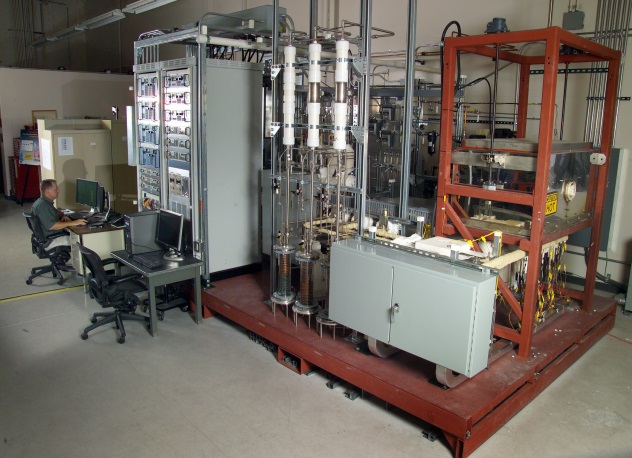Capabilities
Capabilities
Electrochemical and Durability Performance Evaluation of High Temperature Electrolysis Cells and Stacks
Laboratory
Idaho National Laboratory (INL)Capability Expert
Dong Ding, Micah CasteelClass
CharacterizationNode Readiness Category
1: High-Temperature Electrolysis (HTE)Description
Idaho National Laboratory (INL) has a well-established capability for performance testing of solid-oxide cells and stacks, operating in the electrolysis mode for efficient hydrogen production from steam. Capabilities range from fundamental characterization of button cells [1] and single cells to multi-kW testing of large stack configurations [2]. On-line diagnostic capabilities include electrochemical impedance spectroscopy, sweep and cyclic voltammetry, reversible operation with power supplies and electronic loads, plus a wide range of supporting instrumentation and hardware. The INL high-temperature laboratory includes seven test stands for small-scale to multi-kW testing, including a high-pressure test stand. INL also has a significant array of advanced solid oxide electrolysis cell (SOEC) post-test examination capabilities, including SEM/EDS, Auger electron spectroscopy, Raman spectroscopy, CT scan, Local Electrode Atom Probe microscopy, Positron Annihilation Spectroscopy, Glow Discharge Atomic Emission Spectrometer, and surface profilometry. INL has also supported advanced analytical methods for prediction of the behavior of solid-state materials at the operating conditions of SOECs, including atomistic modeling methods [3]. Under the HydroGen EMN initiative, INL would work together with industry, university, and National Laboratory partners in the characterization and optimization of SOEC material sets for improved performance and durability utilizing advanced technologies such as computational materials engineering, additive manufacturing, and advanced diagnostics. Materials research is needed for interconnects, interconnect coatings, contact layers, seals, electrodes, and electrolyte materials.
Capability Bounds
Existing capability ranges from single-cell to multi-kW cells and stack, operating at ambient or elevated pressure (up to 700 psi).
Unique Aspects
Specific expertise and laboratory capabilities directly focused on HTE and SOEC technologies have been developed at INL. INL served as the lead laboratory for HTE under the DOE-NE Nuclear Hydrogen Initiative (NHI). An independent review team, with members from academia and industry, was hired by DOE to evaluate NHI technologies including HTE, sulfur-iodine thermochemical, and hybrid sulfur processes. After a comprehensive review process, the team recommended HTE as the most appropriate near-term advanced hydrogen production technology for further development. This recommendation came about largely as a result of the successful program completed at INL.
Availability
The INL HTE laboratory currently has 5 test stations available for materials research, including all of the instrumentation and capabilities mentioned above.
Benefit
HTE features inherently higher electrical-to-hydrogen efficiency compared to conventional water electrolysis, based on thermodynamic considerations. In addition, high-temperature operation insures highly active kinetics, such that precious metal catalysts are not needed. INL has been a world-class contributor to the development of this technology. The INL HTE laboratory can serve as a centralized testing and screening center for HTE materials research, in collaboration with industry and university partners.
Images

Figure 1. INL high-temperature electrolysis laboratory.

Figure 2. Integrated laboratory scale 15 kW HTE demonstration facility at INL.
References
- J. E. O'Brien, C. M. Stoots, J. S. Herring, P. A. Lessing, J. J. Hartvigsen, S. Elangovan, "Performance Measurements of Solid-Oxide Electrolysis Cells for Hydrogen Production from Nuclear Energy," Journal of Fuel Cell Science and Technology 2 (August 2005): 156-163.
- X. Zhang, J. E. O'Brien, C. Zhou, G. Housley, G. Tao, "Experimental Design, Operation, and Results of a 4 kW High Temperature Steam Electrolysis Unit," Journal of Power Sources 297 (November 2015): 90-97.
- S. Rashkeev, M. Glazoff, "Control of Oxygen Delamination in Solid Oxide Electrolyzer Cells via Modifying Operational Regime," Applied Physics Letters 99, no. 17 (October 2011).
